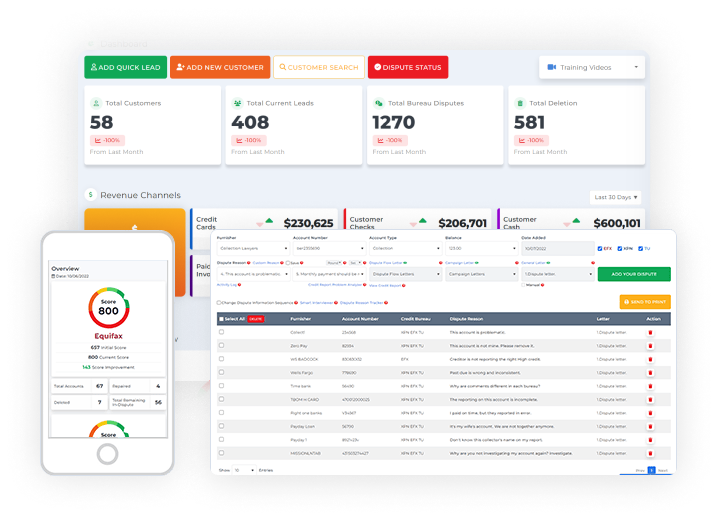Repairing your credit is a journey, but there’s nothing more frustrating than receiving a stall letter from a credit bureau. These letters are used by credit bureaus as a delay tactic, often making consumers feel stuck and unsure of how to proceed with their disputes. The good news is that with the right approach, you can overcome these tactics and keep your credit repair progress on track.
In this article, I’ll share expert tips on how to handle common credit bureau stall tactics. You’ll also get a free Stall Letter Response Guide, which outlines 15 proven ways to respond to these letters and ensure your disputes are investigated. Let’s dive into the strategies that will help you beat the stall.
Start Today and Explore the Features Firsthand!
What is a Credit Bureau Stall Letter?
A credit bureau stall letter is a common response from credit bureaus when you dispute information on your credit report. Instead of addressing the dispute, they might send a letter stating that your dispute is frivolous, suspicious, or potentially submitted by a third party. Essentially, it’s a way to delay the investigation or stop it altogether if you don’t respond properly.
Stall letters come in a few different forms:
- Frivolous Dispute Letter: This claims your dispute lacks merit or is repetitive.
- Suspicious Dispute Letter: This suggests your dispute wasn’t submitted by you or is fraudulent.
- Third-Party Involvement Letter: This asserts that a credit repair company or another third party is handling your dispute, which can cause further scrutiny.
Understanding the type of stall letter you’ve received is the first step toward responding effectively. Let’s break down how to tackle each one.
How to Overcome Credit Bureau Stall Tactics: A Step-by-Step Plan

Handling credit bureau stall tactics effectively requires a clear understanding of the type of stall letter you’ve received and a well-planned response. By following this step-by-step plan, you’ll be prepared to tackle the issue and get the bureau to move forward with your dispute.
The most important thing is not to let these stall letters discourage you. With persistence and the right approach, you can get past the delays.
Step #1: Recognize the Type of Credit Bureau Stall Letter
The first step to overcoming any stall tactic is recognizing the type of credit bureau stall letter you’ve received. These letters are designed to slow down the dispute process, but they also provide an opportunity for you to strengthen your case.
Let’s break down the three most common types:
- Frivolous Dispute Letter: This letter will tell you that your dispute is either repetitive or lacks sufficient evidence. The bureau may claim they’ve already verified the information you’re disputing and ask why you’re submitting the same dispute again.
- Suspicious Dispute Letter: A suspicious dispute letter accuses you of submitting a fraudulent or unauthorized dispute. The bureau may claim that your dispute appears suspicious and request additional proof of your identity or your connection to the account in question.
- Third-Party Involvement Letter: If the bureau suspects you’re using a third-party credit repair company to submit your disputes, they might send this letter. It often includes a statement implying that third-party submissions may not be allowed, which isn’t entirely accurate. You still have the right to dispute inaccurate information on your report, regardless of whether you’re working with a third-party service.
Recognizing the type of letter you’ve received is the first critical step toward crafting a strong response.
Start Today and Explore the Features Firsthand!
Step #2: Gather Supporting Documentation for Your Credit Bureau Stall Letter

Once you’ve identified the stall letter from the credit bureau, the next step is to gather all relevant supporting documentation. Credit bureaus often send these letters as a way to test whether you’ll continue pushing your dispute. By responding with strong evidence, you can prove that your dispute is valid and should be investigated.
For any type of stall letter, include:
- Double Proof of Identity: Always include multiple forms of identification, such as a copy of your driver’s license, passport, or state-issued ID. Additionally, provide proof of your current address, like a utility bill, lease agreement, or bank statement. This helps confirm your identity and counters any claims that the dispute wasn’t submitted by you.
- Relevant Documents: If you’re disputing specific items on your credit report, such as an incorrect balance or account status, provide documentation that supports your claim. For example, you might include account statements, payment history, or correspondence from the creditor that proves the information on your credit report is inaccurate.
Example: Handling a Suspicious Dispute Letter
Suppose you receive a suspicious dispute letter that suggests your dispute wasn’t submitted by you. To address this, you can respond with a letter that includes double proof of your identity, such as a copy of your ID and a recent utility bill. In your letter, clearly state that you, as the consumer, submitted the dispute and are legally entitled to challenge any inaccurate information on your report. This direct response forces the bureau to move forward with their investigation.
Step #3: Write a Tailored Response to the Credit Bureau Stall Tactics
Once you’ve gathered your documents, it’s time to craft a response. A well-written, personalized response letter is essential when dealing with credit bureau stall tactics. Credit bureaus often rely on the fact that many consumers don’t know how to respond or will send generic letters that don’t directly address the issue. By taking the time to write a specific response that matches the type of stall letter you’ve received, you greatly improve your chances of a successful dispute resolution.
Here’s how to structure your response to each type of stall letter:
- Frivolous Dispute Letter: If the bureau claims your dispute is frivolous, it’s important to submit new information. You can change your dispute reason or provide additional supporting documents that weren’t included in your initial submission. In your letter, reference the Fair Credit Reporting Act (FCRA), which requires credit bureaus to investigate your dispute within 30 days. Remind them that they are legally obligated to handle your dispute and investigate the new information you’ve provided.
- Suspicious Dispute Letter: For suspicious disputes, respond by including additional proof of identity, as well as a clear explanation that you are the one who submitted the dispute. Again, reference the FCRA and state that the bureau must continue investigating your dispute and not delay the process due to unfounded suspicions.
- Third-Party Involvement Letter: If the bureau claims that your dispute is being handled by a third party, respond by asserting your right as a consumer to dispute inaccurate information, regardless of any third-party involvement. Include any documentation that proves you are the one managing your dispute. Also, mention that the FCRA protects your rights, and the bureau must investigate your claims within the required timeframe.
Step #4: Escalate If the Credit Bureau Stall Tactics Continue
Sometimes, despite your best efforts, credit bureaus may continue to delay or refuse to investigate your dispute. If this happens, it’s time to escalate. Escalating your dispute sends a clear message to the bureau that you won’t allow them to ignore your claims and that you’re prepared to take further action if necessary.
Here are three ways to escalate:
- File a Complaint with the Consumer Financial Protection Bureau (CFPB): If the credit bureau fails to investigate your dispute within 30 days, file a formal complaint with the Consumer Financial Protection Bureau (CFPB). This government agency oversees credit bureaus and ensures that they comply with legal standards. Filing a complaint can prompt faster action from the bureau.
- Send a Certified Letter: Sending your dispute response or follow-up letters via certified mail ensures that you have a paper trail showing that the credit bureau received your correspondence. This can be useful if you need to escalate the matter further or prove that you’ve followed the necessary steps.
- Request a Full Explanation: If the bureau dismisses your dispute without proper investigation, request a detailed explanation of how they verified the information on your report. This holds them accountable for following the investigation process and can prevent them from dismissing your dispute too quickly.
Escalating a dispute is a powerful way to ensure that your claims are taken seriously and that the credit bureau follows the law.
Start Today and Explore the Features Firsthand!
Step #5: Keep Detailed Records of All Communication

Maintaining thorough records throughout the credit dispute process is essential. Every piece of communication between you and the credit bureaus should be documented, as this will be critical if you need to escalate the dispute or take legal action.
Make sure to keep copies of:
- All dispute letters you send to the credit bureau
- Receipts from certified mail (proving they received your letters)
- Any responses or letters from the credit bureau
- Proof of identity and supporting documentation
These records will serve as evidence that you’ve followed all required procedures and can be used to support your case if you need to file a complaint or escalate the issue further.
Free Stall Letter Response Guide: 15 Ways to Tackle Credit Bureau Stalls
Navigating credit bureau stall tactics can be challenging, but having the right resources makes all the difference. To help you address these stall letters effectively, I’ve created a free Stall Letter Response Guide that includes 15 detailed strategies for responding to these delays and keeping your credit repair efforts on track.
This guide provides:
- Pre-written response letters for different types of stall letters (frivolous, suspicious, and third-party involvement)
- Clear instructions on what documentation to include in each response
- Tips for escalating your dispute if the bureau fails to investigate within the legal timeframe
You can download this free guide by following the link below and use it as a resource whenever you receive a stall letter from a credit bureau.
Start Today and Explore the Features Firsthand!
Automate and Simplify Disputes with Client Dispute Manager Software

Manually responding to credit bureau stall letters can be time-consuming, especially when dealing with multiple disputes. Whether you’re working on your own credit or managing disputes for clients, having the right tools can make a significant difference. This is where the Client Dispute Manager Software comes into play.
Client Dispute Manager Software is a powerful solution designed to help you streamline and automate the credit dispute process. It provides pre-built templates for responding to common stall letters and allows you to manage disputes more efficiently, all while ensuring that you meet the legal requirements set forth by the Fair Credit Reporting Act (FCRA).
Key Features of Client Dispute Manager Software
- Pre-Written Response Letters: The software comes with a library of response letters specifically designed for handling credit bureau stall tactics, such as frivolous, suspicious, and third-party involvement claims. These letters are customizable, allowing you to tailor them to each specific dispute.
- Document Management: Easily upload and organize all necessary supporting documents—such as proof of identity, account statements, and other evidence—directly within the software. This ensures that all relevant documentation is included in your dispute submissions.
- Automated Follow-Ups: The software can track the status of your disputes and send automated follow-up letters if the bureau doesn’t respond within the 30-day window required by law. This feature helps ensure that your disputes are not forgotten or ignored.
- Bulk Dispute Submission: If you are handling multiple disputes, the Client Dispute Manager Software allows you to submit bulk dispute letters with ease. This is especially useful for credit repair businesses or individuals who are managing multiple accounts or disputes at once.
- Legal Compliance: The software is built with Fair Credit Reporting Act (FCRA) compliance in mind, ensuring that all dispute letters, timelines, and responses follow the law, which is crucial when dealing with credit bureau stall letters and other delay tactics.
Why Client Dispute Manager Software Is a Game Changer?
Whether you’re facing your first credit bureau stall letter or managing a long list of disputes, Client Dispute Manager Software can transform the way you handle your credit repair process. With automated dispute generation, follow-ups, and compliance features, it removes the guesswork and manual effort from responding to credit bureau stall tactics.
Don’t let stall letters delay your credit repair efforts. Consider using Client Dispute Manager Software to simplify the process, maintain compliance, and keep your credit repair or credit repair business on track.
Common Mistakes to Avoid When Responding to Credit Bureau Stall Tactics
Even with a solid plan in place, it’s easy to make mistakes when responding to credit bureau stall letters. Avoid these common pitfalls to ensure your dispute is handled effectively:
- Sending Generic Responses: One of the biggest mistakes is sending a generic response. Each type of stall letter from a credit bureau requires a tailored response that directly addresses the issue raised in the letter. A one-size-fits-all response is unlikely to resolve the problem.
- Failing to Provide Sufficient Documentation: Always include adequate documentation to support your dispute. Lack of supporting documents is one of the most common reasons disputes are delayed or dismissed.
- Giving Up Too Soon: Don’t let a stall letter discourage you from pursuing your dispute. The credit repair process takes time, and persistence is key. Keep following up and escalate if necessary.
Final Thoughts on Overcoming Credit Bureau Stalls
Responding to credit bureau stall letters can feel like an uphill battle, but with the right approach, you can overcome these delay tactics and ensure your disputes are properly investigated. By following the steps outlined in this guide, you’ll be better equipped to tackle any credit bureau stall tactic that comes your way.
Don’t forget to download the free Stall Letter Response Guide to access 15 strategies for handling stall letters effectively. Persistence is key, and with the right tools and documentation, you can keep your credit repair efforts moving forward, no matter what obstacles arise.

Mark Clayborne
Mark Clayborne specializes in credit repair, starting and running credit repair businesses. He's passionate about helping businesses gain freedom from their 9-5 and live the life they really want. You can follow him on YouTube.
Start Today and Explore the Features Firsthand!
Below Is More Content For Your Review:
- How Do Credit Bureau Stall Tactics Impact Your Credit Disputes?
- Winning the Dispute War: Proven Tactics for Effective Credit Repair



